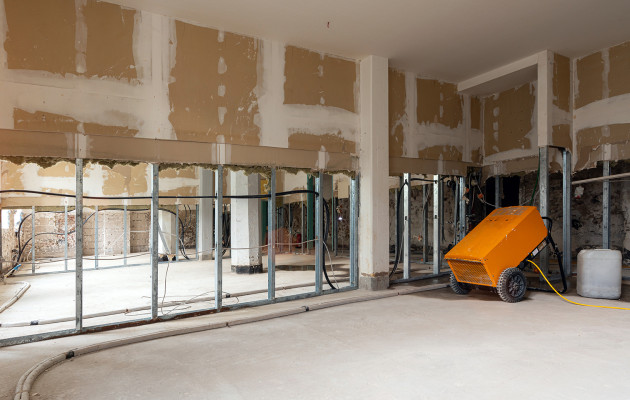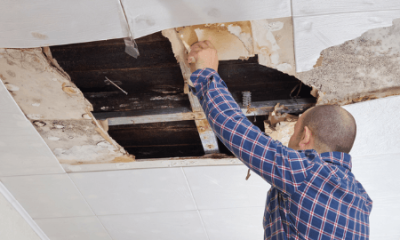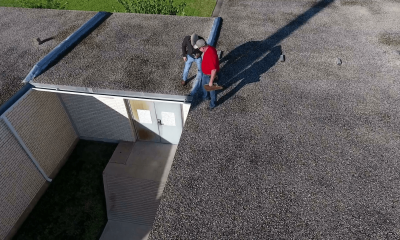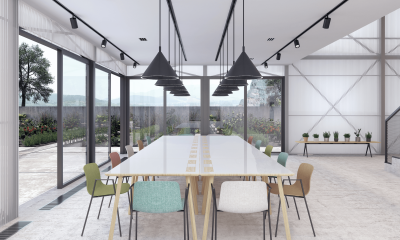Decoding “Business Interruption” Insurance
When business operations are stalled due to a covered property loss – such as a natural disaster, fire, or water damage – restoring the property to its original condition is your number one priority as a business owner. Filing a business interruption claim under your commercial insurance coverage can help replace the lost income and help pay for additional expenses to keep the business partially operating. However, the process for such a claim can be highly technical, time-consuming, and difficult to navigate alone.
Whether you own rental properties, a retail space, restaurant, manufacturing facility, or another entity that has property damage, don’t get caught unprepared and overwhelmed should disaster strike. At Jansen/Adjusters International, we have helped business owners successfully navigate business interruption claims for more than 44 years. We hope this advice will help you learn more about the intricacies of a business interruption claim for your specific industry and increase your chances of receiving an optimal settlement should disaster strike.
Here are basic business interruption calculations to consider when filing a claim for manufacturing operations, rental properties, restaurants, and retail businesses:
1. Manufacturing
When it comes to business interruption claims, the manufacturing industry presents a perfect example of how complex insurance policies can be. With manufacturing business insurance claims, a few of the most significant considerations include the stage of the goods, variable versus fixed costs, idle capacity, and extra expenses.
Stage of Goods
Because manufacturing operations have multiple categories of inventory – starting from raw materials and work-in-process to finished goods and shipments – it is not always clear where ownership of the goods transfers and/or determining the exact value at the various stages. In an insurance claim, this can present a challenge in figuring out what exactly is covered under the policy. An insurance carrier may often overlook this small, but critical, distinguishing factor. A public adjuster can assist with identifying the stage of goods, helping to save clients a significant amount of time and money.
Variable vs. Fixed Cost
If a business has multiple manufacturing lines, the variable and fixed costs for each could differ. Depending on how the business accounts for the marginal cost of each additional product, the insurance settlement for lost income could look very different.
Some manufacturers will apply some overhead into their cost of goods sold, while the insurance company may deduct all the cost of goods sold. To obtain the best possible settlement, a public adjuster can help the business owner evaluate the best method to capture overhead expenses.
Idle Capacity
Some manufacturers reserve their idle capacity – the remaining amount of capacity of a manufacturer to produce goods that are not regularly used – to fulfill larger orders, and/or leave room for the potential to offer their products to customers at a discount, often on a sporadic basis.
A public adjuster can examine the manufacturer’s history of fulfilling orders from this idle capacity and determine the possibility of a large order drawing from it, in which case the additional revenue could likely be covered under the policy.
Extra Expenses
Following a disaster, a manufacturer's insurance policy may accommodate for extra expenses to ensure customer retainment and allow for partial operations.
Restoring business operations as soon as possible is vital to surviving a loss. Under “extra expenses,” the cost of a temporary location can be covered to continue essential production while the original location is unavailable for use or expedite expenses to replace damaged essential machinery in a timely manner.
In one case, Adjusters International helped a manufacturing client retain customers through “extra expenses” coverage by purchasing similar products from a competitor to resell to its own customers. This was critical to the business surviving when operations were seized. Continuing to fulfill customer orders ensured that the manufacturer did lose business when not having the inventory for orders that have already been placed.
2. Rental Properties
For owners of commercial real estate, hotels, office buildings, or apartments, the ever-shifting occupancy levels can play a significant role in further complicating a business interruption claim to recoup lost rent. Often, hiring a public adjuster who advocates for the policyholder can help make the process more personalized to an individual property’s situation, leading to a better settlement.
Rental Income
Hotel rates are constantly changing with the goal of maintaining as close to full occupancy as possible while also generating profit. When calculating lost income for a hotel, an insurance company may not take higher rates for holiday or seasonal dates into account. A public adjuster can research the actual profits a hotel has made during the time in question in past years to obtain a more accurate average daily room revenue.
When it comes to apartments, few multifamily buildings will have full occupancy throughout the year due to transitional vacancies between tenants. Depending on when the rent roll is evaluated, vacancy rates can be drastically different, leading to discrepancies. Similar to evaluating a hotel’s average daily room revenue, a public adjuster is often able to have the vacancy rate reevaluated to reflect a more accurate number, therefore optimizing the policyholder’s settlement for lost income.
Continuing Expenses
Apartment buildings and hotels often contract services for maintenance, cleaning, landscaping, etc. Many insurance companies may not consider these services to be continuing expenses when business is stalled during a disaster. Using the terms of a signed contract between the property owner and the service provider, a public adjuster can advocate that the contracted services are covered under continuing expenses so they can be reimbursed by the insurance company. Not only does this salvage the relationships between the business owner and contractors, but it helps relieve the financial burden of paying out of pocket.
Another common continuing expense is the electricity bill. During reconstruction, the usage is typically much higher than during normal operations due to heavy machinery and equipment. Because the property owner will be paying more, it can be possible to negotiate for the actual amount that was spent during reconstruction instead of the average electricity use under normal circumstances.
Extra Expenses
Much like in a manufacturing claim, there will be additional expenses associated with recovery and repair of a hotel, apartments, or office building. Like a manufacturing claim, a landlord or real estate owner will likely want to keep their tenants as happy and comfortable as possible after a disaster.
However, it is highly unlikely that most tenants will be able to stay in a unit if they are unable to occupy it due to damages. Depending on the landlord’s insurance policy, canceled leases may be covered under rent abatement preventing the loss of revenue while the units are uninhabitable.
Another potential covered extra expense is tenant relocation. Public adjusters will research the policy to see if it will pay the cost for a property owner to move tenants into another unit or location, either temporarily or permanently depending on the situation, allowing the landlord to maintain goodwill with their renters.
Extended Period of Indemnity
Typically, business interruption coverage ends after the structure is restored or rebuilt. If, for example, an apartment building is vacated due to a loss, it is unlikely that it will be able to fully lease all its units immediately upon reopening. The extended period of indemnity endorsement covers the business owner’s lost income for 30, 60, or even 90 days past the rebuilding. To quickly fill vacancies, property owners may offer perks such as a month of free rent to gain a competitive advantage in the market. Under the extended period of indemnity, any strategies that will help the building fill occupancy faster including increased advertising and agent expenses could be covered under the property owner’s insurance policy. In addition, the landlord might also be covered for any rents they are still losing during the extended period.
3. Restaurants
A business can be disrupted by a variety of factors, but restaurant fires are an especially common disaster that can prevent all customers from dining. It is especially crucial for restaurant owners to get their business back up and running in a timely manner to ensure profitability and retain key staff.
Revenue Cycles
Public adjusters understand that the most critical element to consider when working on a restaurant claim is the seasonal nature of profitability. When dealing with such a claim, insurance companies tend to take an average of a restaurant's profit over a twelve-month period. However, many restaurant owners find themselves making a significant profit during specific parts of the year, while they can lose money at other times.
For instance, a restaurant located in a tourist destination could make a year’s worth of profit during one tourist season, which could be as short as one month or a quarter of the year. This means that a yearly average profit might not result in the most optimal settlement, especially if the restaurant is closed during its most profitable season. At Jansen/Adjusters International we understand the nature of the restaurant business, and our public adjusters can step in to make additional calculations which the insurance company might not have initially considered.
4. Retail Services
Retail stores can also be subject to business interruption claims due to disasters from fire and water damage, to hail and tornadoes. Like restaurants, retailers can also face challenges of a seasonal business, which can lead to accounting discrepancies and difficulties when filing a claim. A public adjuster can navigate these challenges to help retail owners negotiate the fairest claim.
Seasonality
Retail stores can also have specific times of the year when revenue is greater due to season changes or tourism flow. In certain types of retail, such as ski or surf shops, businesses are only open part of the year, which can lead to a greater loss in profit should the location have to close during peak season due to disaster. In order to allow for the most accurate settlement, a public adjuster can assist with additional calculations that take seasonality into account.
Accounting inconsistencies or inaccuracies
When smaller retail businesses’ accounting information is not as consistent or thorough as larger businesses, they can be penalized for inaccuracies. Oftentimes, a public adjuster can work with a small business client to have its financial statements restated to reflect the actual loss.
Temporary Location for Operations
Should a retail location be unusable after a disaster, a public adjuster can advocate for the store to temporarily rent another location to continue operating while the original building is undergoing repair. The rent for the temporary location could be reimbursed under the policyholder’s coverage.
Brands and Labels Coverage
Following a disaster, the insurance company is entitled to any remaining economic value of salvaged goods if the insured is fully compensated for those losses. Under brands and labels coverage, the insurance company must destroy these items instead, thereby protecting the policyholder’s brand.
In the event, your business experiences a loss and you need to file a business interruption claim, make sure you have an expert on your side to help you through the unique challenges your industry may present. Our public adjusters at Jansen/Adjusters International serve as your advocates, removing the burden of navigating the claim alone and saving you time, money, and stress so you can focus on restoring your business.
Contact us today with your business interruption insurance claim, and we will help you determine the best course of action to get your business back on track.
This article originally appeared in Adjusters International/MBC's newsroom.








